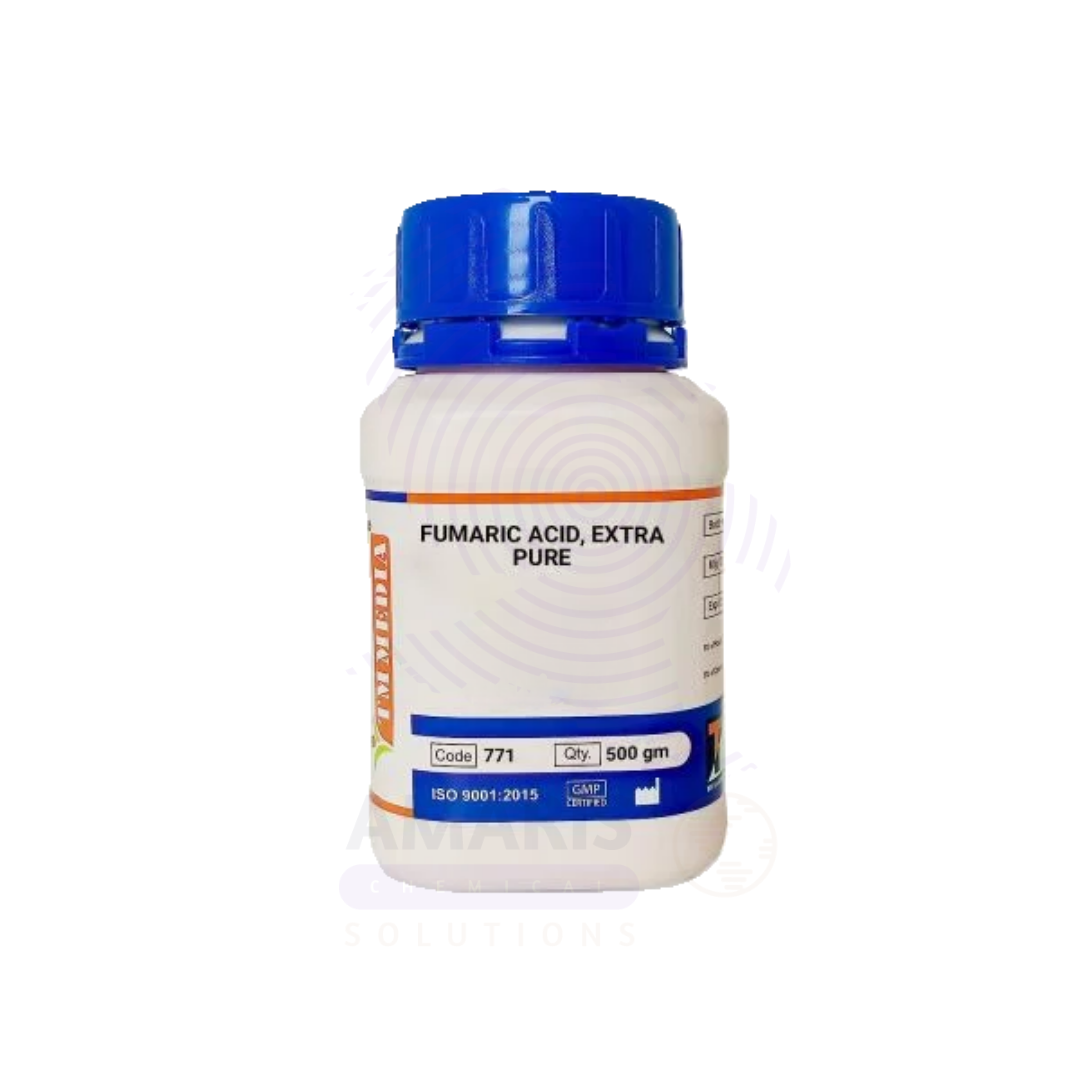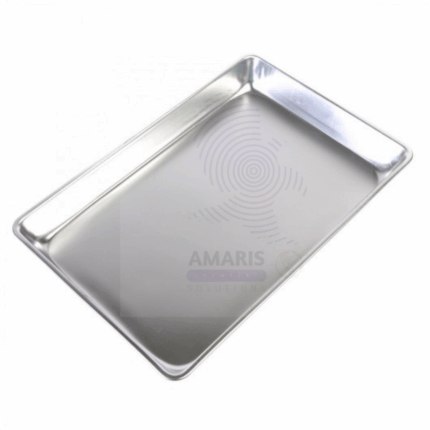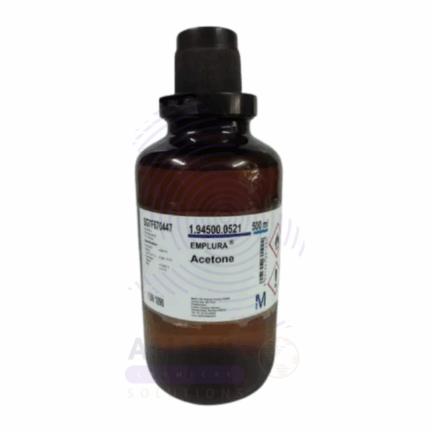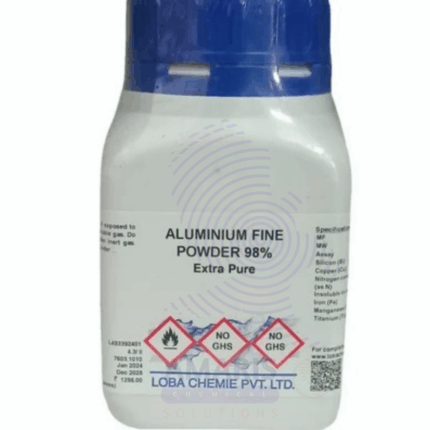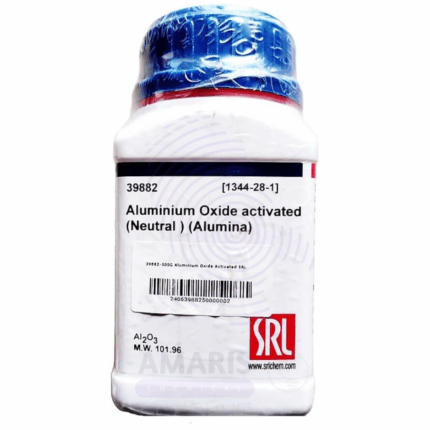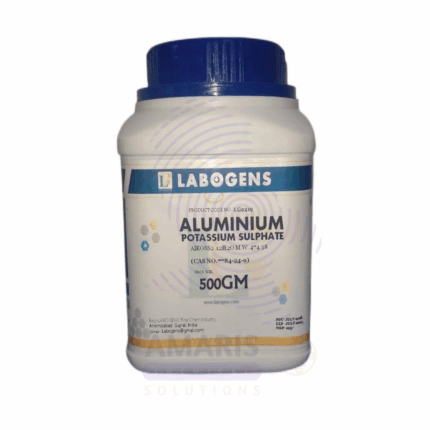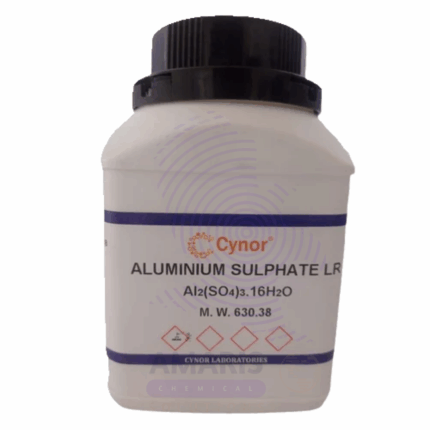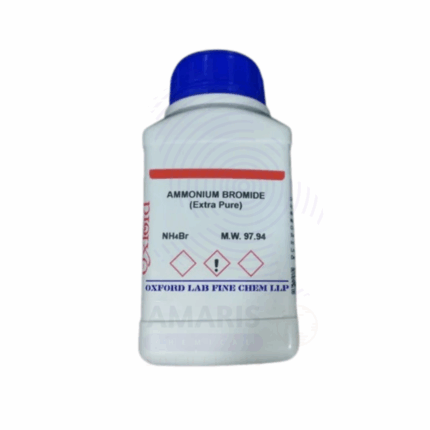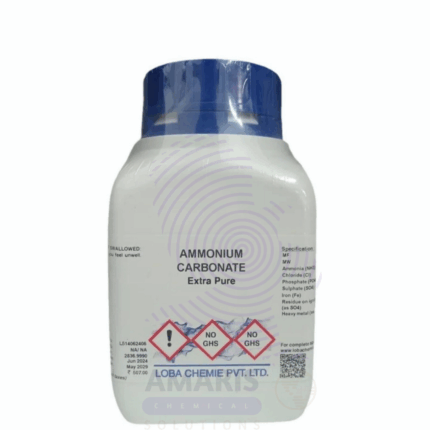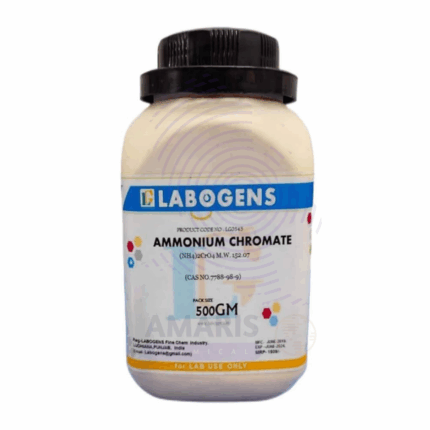Fumaric Acid Extra Pure
$ 18.65 Original price was: $ 18.65.$ 18.54Current price is: $ 18.54.
Fumaric Acid Extra Pure is a white crystalline organic compound known for its use as a food acidulant, a chemical intermediate, and a reagent in laboratory analysis. This trans-isomer of butenedioic acid plays a significant role in the Krebs cycle and is commonly used in biochemical and pharmaceutical research. In laboratories, it serves as a standard for titrations and a pH modifier in formulations. Its excellent stability, solubility in alcohol, and high purity make it suitable for precision applications, including quality control testing, analytical chemistry, and synthesis of esters and resins.
Fumaric Acid Extra Pure
Primary Uses
- Biochemical research:
Used in studies of the citric acid (Krebs) cycle, as fumaric acid is a key intermediate involved in cellular respiration. - pH adjustment and buffer systems:
Acts as a mild acidulant or buffer component in analytical and biological experiments due to its stable, weakly acidic properties.
Secondary Uses
- Pharmaceutical formulation testing:
Employed in solubility and stability testing of active pharmaceutical ingredients under acidic conditions. - Polymer and resin research:
Used in experiments related to alkyd resin or polyester synthesis, especially in cross-linking studies. - Food chemistry and simulation:
Utilized in food additive research and as a control substance in studies involving acidity regulators.
| PACK SIZE |
250 grams Plastic Tin |
|---|
1. Basic Identification Attributes
- Chemical Name: Fumaric Acid
- Other Names: Trans-butenedioic acid
- Chemical Formula: C₄H₄O₄
- CAS Number: 110-17-8
- Molecular Weight: 116.07 g/mol
- Grade: Extra Pure (Laboratory Reagent Grade)
- Appearance: White crystalline powder
- Odor: Odorless
- Taste: Sour, acidic
2. Physical & Chemical Properties
- Melting Point: ~287 °C (with decomposition)
- Solubility: Slightly soluble in water, soluble in alcohol and ether
- pKa values: ~3.0 and ~4.4
- Boiling Point: Decomposes before boiling
- Stability: Stable under standard lab conditions
- Isomerism: Trans-isomer of maleic acid
3. Safety & Hazard Attributes
- Hazard Classification (GHS):
⚠️ Irritant - Hazard Statements:
- H319: Causes serious eye irritation
- H335: May cause respiratory irritation
- PPE Requirements:
- Lab coat
- Gloves (nitrile or latex)
- Safety goggles
- Dust mask if powder handling is excessive
- First Aid Measures:
- Inhalation: Move to fresh air; seek medical attention if symptoms persist
- Skin Contact: Wash thoroughly with soap and water
- Eye Contact: Rinse cautiously with water for several minutes
- Ingestion: Rinse mouth; seek medical advice if large amounts ingested
4. Storage & Handling Attributes
- Storage Conditions:
- Store tightly sealed in a dry, cool, and well-ventilated area
- Keep container tightly closed
- Protect from moisture and strong bases
- Handling Notes:
- Avoid inhalation of dust
- Use in a fume hood if dust generation is significant
- Avoid contact with eyes and prolonged skin exposure
5. Regulatory & Compliance Attributes
- Food/Pharma Relevance:
- GRAS (Generally Recognized As Safe) in food applications (non-lab grade)
- Listed in FCC and pharmacopeias for appropriate grades
- Labeling Compliance:
- GHS-compliant labeling required for lab-grade use
- Not listed as a carcinogen or environmentally hazardous
6. Laboratory Applications
- Primary Uses:
- Acidulant in analytical chemistry
- Buffering agent in pH adjustment and titration
- Used in organic synthesis and esterification studies
- Secondary Uses:
- Antioxidant testing and polymer crosslinking studies
- Research on unsaturated dicarboxylic acids
- Referencing standard in spectroscopy or chromatography
SAFETY PRECAUTIONS
Personal Protective Equipment (PPE):
- Wear a lab coat, nitrile gloves, and protective goggles.
- Use a dust mask or work in a fume hood if powder is airborne.
Handling:
- Avoid inhalation of dust or contact with skin and eyes.
- Do not eat, drink, or smoke while using this product.
- Wash hands thoroughly after handling.
Storage:
- Store in a tightly closed container in a cool, dry, and well-ventilated place.
- Keep away from incompatible substances such as strong bases and oxidizing agents.
- Protect from moisture and direct sunlight.
FIRST AID MEASURES
Inhalation:
- Remove the person to fresh air.
- Seek medical attention if respiratory symptoms persist.
Skin Contact:
- Wash thoroughly with soap and water.
- Remove contaminated clothing and wash before reuse.
- Get medical advice if irritation occurs.
Eye Contact:
- Rinse cautiously with water for several minutes.
- Remove contact lenses if present and easy to do.
- Continue rinsing and seek medical attention if irritation persists.
Ingestion:
- Rinse mouth with water.
- Do not induce vomiting.
- Seek medical attention if symptoms occur.
FIRE FIGHTING MEASURES
Flammability:
- Not highly flammable, but fine dust may form explosive mixtures with air.
- May burn if involved in a fire.
Extinguishing Media:
- Use dry chemical, CO₂, or foam.
- Water spray can be used to cool containers but may spread dust.
Hazardous Combustion Products:
- May emit carbon oxides (CO, CO₂) under fire conditions.
Firefighter Protection:
- Wear self-contained breathing apparatus (SCBA) and full protective gear.
- Avoid inhalation of fumes or dust during firefighting.
Related products
Acetone Extra Pure
Aluminium Metal Fine Extra Pure
Aluminium Oxide Active Neutral Extra Pure
Aluminium Potassium Sulphate Hydrated Extra Pure
Aluminium Sulphate Anhydrous Extra Pure
Ammonium Bromide Extra Pure
Ammonium Carbonate Extra Pure
Ammonium Carbonate Extra Pure is a high-quality, white crystalline solid widely used across various scientific, industrial, and food-related applications. Manufactured to stringent purity standards, this compound is ideal for laboratories and processes that demand high-grade reagents. With its characteristic ammonia-like odor and ability to decompose upon heating, ammonium carbonate plays a versatile role in both chemical reactions and physical processes.
In aqueous solution, ammonium carbonate breaks down into ammonium bicarbonate and ammonium carbamate, further releasing ammonia (NH₃) and carbon dioxide (CO₂) upon heating. This property makes it especially useful in applications that require controlled gas release or temporary pH modification.


 Preservatives(food)
Preservatives(food) Flavor Enhancers
Flavor Enhancers Acidulants
Acidulants Sweeteners
Sweeteners Antioxidants
Antioxidants Colorants(food)
Colorants(food) Nutraceutical Ingredients (food)
Nutraceutical Ingredients (food) Nutrient Supplements
Nutrient Supplements Emulsifiers
Emulsifiers
 Collectors
Collectors Dust Suppressants
Dust Suppressants Explosives and Blasting Agents
Explosives and Blasting Agents Flocculants and Coagulants
Flocculants and Coagulants Frothers
Frothers Leaching Agents
Leaching Agents pH Modifiers
pH Modifiers Precious Metal Extraction Agents
Precious Metal Extraction Agents
 Antioxidants(plastic)
Antioxidants(plastic) Colorants (Pigments, Dyes)
Colorants (Pigments, Dyes) Fillers and Reinforcements
Fillers and Reinforcements Flame Retardants
Flame Retardants Monomers
Monomers Plasticizers
Plasticizers Polymerization Initiators
Polymerization Initiators Stabilizers (UV, Heat)
Stabilizers (UV, Heat)
 Antifoaming Agents
Antifoaming Agents Chelating Agents
Chelating Agents Coagulants and Flocculants
Coagulants and Flocculants Corrosion Inhibitors
Corrosion Inhibitors Disinfectants and Biocides
Disinfectants and Biocides Oxidizing Agents
Oxidizing Agents pH Adjusters
pH Adjusters Scale Inhibitors( water)
Scale Inhibitors( water)
 Antioxidants(cosmetic)
Antioxidants(cosmetic) Emollients
Emollients Fragrances and Essential Oils
Fragrances and Essential Oils Humectants
Humectants Preservatives
Preservatives Surfactants(cosmetic)
Surfactants(cosmetic) Thickeners
Thickeners UV Filters
UV Filters
 Fertilizers
Fertilizers Soil Conditioners
Soil Conditioners Plant Growth Regulators
Plant Growth Regulators Animal Feed Additives
Animal Feed Additives Biostimulants
Biostimulants Pesticides (Herbicides, Insecticides, Fungicides)
Pesticides (Herbicides, Insecticides, Fungicides)
 Active Pharmaceutical Ingredients (APIs)
Active Pharmaceutical Ingredients (APIs) Excipients
Excipients Solvents(pharmaceutical)
Solvents(pharmaceutical) Antibiotics
Antibiotics Antiseptics and Disinfectants
Antiseptics and Disinfectants Vaccine Adjuvants
Vaccine Adjuvants Nutraceutical Ingredients (pharmaceutical)
Nutraceutical Ingredients (pharmaceutical) Analgesics & Antipyretics
Analgesics & Antipyretics
 Analytical Reagents
Analytical Reagents Solvents(lab)
Solvents(lab) Chromatography Chemicals
Chromatography Chemicals Spectroscopy Reagents
Spectroscopy Reagents microbiology-and-cell-culture-reagents
microbiology-and-cell-culture-reagents Molecular Biology Reagents
Molecular Biology Reagents Biochemical Reagents
Biochemical Reagents Inorganic and Organic Standards
Inorganic and Organic Standards Laboratory Safety Chemicals
Laboratory Safety Chemicals Specialty Laboratory Chemicals(Special Laboratory Equipment)
Specialty Laboratory Chemicals(Special Laboratory Equipment)
 Demulsifiers
Demulsifiers Hydraulic Fracturing Fluids
Hydraulic Fracturing Fluids Scale Inhibitors(oil)
Scale Inhibitors(oil) Surfactants(oil)
Surfactants(oil) Drilling Fluids
Drilling Fluids
 Dyes and Pigments
Dyes and Pigments Bleaching Agents
Bleaching Agents Softening Agents
Softening Agents Finishing Agents
Finishing Agents Antistatic Agents
Antistatic Agents
 Admixtures
Admixtures Waterproofing Agents
Waterproofing Agents Sealants and Adhesives
Sealants and Adhesives Curing Compounds
Curing Compounds Concrete Repair Chemicals
Concrete Repair Chemicals Anti-Corrosion Coatings
Anti-Corrosion Coatings
 Surfactants(cleaning)
Surfactants(cleaning) Builders
Builders Enzymes
Enzymes Solvents (Cleaning)
Solvents (Cleaning) Fragrances
Fragrances
 Electronic Chemicals
Electronic Chemicals Catalysts
Catalysts Lubricants
Lubricants Photographic Chemicals
Photographic Chemicals Refrigerants
Refrigerants Automotive chemicals
Automotive chemicals Pyrotechnic Chemicals
Pyrotechnic Chemicals
 Biodegradable Surfactants
Biodegradable Surfactants Bio-based Solvents
Bio-based Solvents Renewable Polymers
Renewable Polymers Carbon Capture Chemicals
Carbon Capture Chemicals Wastewater Treatment Chemicals
Wastewater Treatment Chemicals
 Pigments
Pigments Solvents(paint)
Solvents(paint) Specialty Coatings
Specialty Coatings Binders/Resins
Binders/Resins Additives
Additives Driers
Driers Anti-Corrosion Agents
Anti-Corrosion Agents Functional Coatings
Functional Coatings Application-Specific Coatings
Application-Specific Coatings
 Fresh Herbs
Fresh Herbs Ground Spices
Ground Spices Whole Spices
Whole Spices Spice Blends
Spice Blends Dried Herbs
Dried Herbs
 Leavening Agents
Leavening Agents Dough Conditioners
Dough Conditioners Flour Treatments
Flour Treatments Fat Replacers
Fat Replacers Decoratives
Decoratives Preservatives(baking)
Preservatives(baking)
 Plasticizers & Softeners
Plasticizers & Softeners Reinforcing Agents
Reinforcing Agents Adhesion Promoters
Adhesion Promoters Vulcanizing Agents
Vulcanizing Agents Antidegradants
Antidegradants Blowing Agents
Blowing Agents Fillers & Extenders
Fillers & Extenders Accelerators & Retarders
Accelerators & Retarders